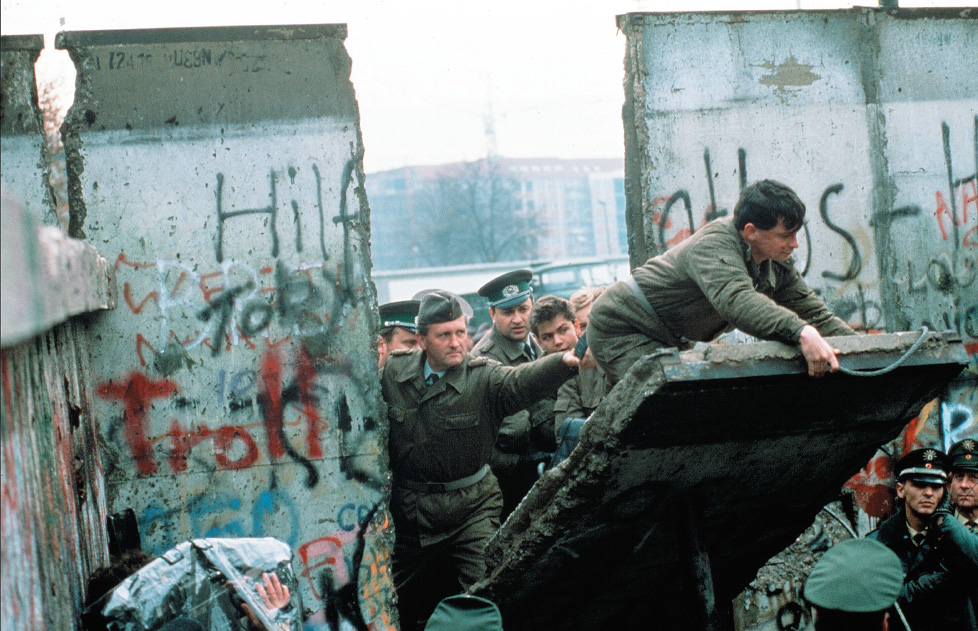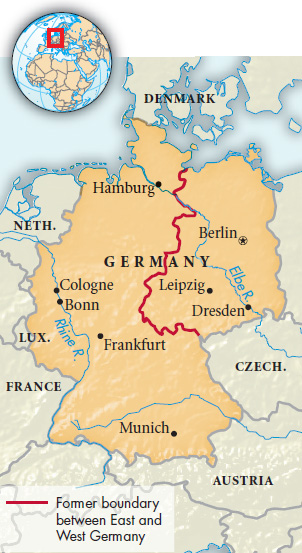A History of Western Society: Printed Page 1001
A History of Western Society, Value Edition: Printed Page 1012
German Unification and the End of the Cold War
The dissolution of communism in East Germany that began in 1989 reopened the “German question” and raised the threat of renewed Cold War conflict over Germany. Taking power in October 1989, East German reform Communists, enthusiastically supported by leading intellectuals and former dissidents, wanted to preserve socialism by making it genuinely democratic and responsive to the needs of the people. They argued for a “third way” that would go beyond the failed Stalinism they had experienced and the ruthless capitalism they saw in the West. These reformers supported closer ties with West Germany but feared unification, hoping to preserve a distinct East German identity.
Over the next year, however, East Germany was absorbed into an enlarged West Germany, much as a faltering company is swallowed by a stronger rival and ceases to exist. Three factors were particularly important in this outcome. First, in the first week after the Berlin Wall was opened, almost 9 million East Germans — roughly half of the total population — poured across the border into West Germany. Almost all returned to their homes in the east, but the joy of warm welcomes from long-lost friends and relatives and the exhilaration of crossing a long-closed border aroused long-dormant hopes of unity among ordinary citizens.
Second, West German chancellor Helmut Kohl and his closest advisers skillfully exploited the historic opportunity handed them. Sure of support from the United States, whose leadership he had steadfastly followed, in November 1989 Kohl presented a ten-point plan for step-by-step unification in cooperation with both East Germany and the international community. Kohl then promised the struggling citizens of East Germany an immediate economic bonanza — a generous though limited exchange of East German marks in savings accounts and pensions into much more valuable West German marks. This offer helped a well-financed conservative-liberal Alliance for Germany, established in East Germany with the support of Kohl’s West German Christian Democrats, to overwhelm those who argued for the preservation of some kind of independent socialist society in East Germany. In March 1990 the Alliance won almost 50 percent of the votes in an East German parliamentary election, outdistancing the Party of Democratic Socialism (the renamed East German Communist party) (16 percent) and the revived Social Democratic Party (22 percent). The Alliance for Germany quickly negotiated an economic and political union on favorable terms with Kohl.


Third, in the summer of 1990 the crucial international aspect of German unification was successfully resolved. Unification would once again make Germany the strongest state in central Europe and would directly affect the security of the Soviet Union. But Gorbachev swallowed hard — Western cartoonists showed Stalin turning over in his grave — and negotiated the best deal he could. In a historic agreement signed by Gorbachev and Kohl in July 1990, Kohl solemnly affirmed Germany’s peaceful intentions and pledged never to develop nuclear, biological, or chemical weapons. The Germans sweetened the deal by promising enormous loans to the hard-pressed Soviet Union. In October 1990 East Germany merged into West Germany, forming a single nation under the West German laws and constitution.
The peaceful reunification of Germany accelerated the pace of agreements to liquidate the Cold War. In November 1990 delegates from twenty-two European countries joined those from the United States and the Soviet Union in Paris and agreed to a scaling down of all their armed forces. The delegates also solemnly affirmed that all existing borders in Europe, including those of unified Germany and the emerging Baltic States, were legal and valid. The Paris Accord was for all practical purposes a general peace treaty bringing an end to both World War II and the Cold War.
Peace in Europe encouraged the United States and the Soviet Union to scrap a significant portion of their nuclear weapons in a series of agreements. In September 1991 a confident President George H. W. Bush canceled the around-the-clock alert status for American bombers outfitted with atomic bombs, and a floundering Gorbachev quickly followed suit with his own forces. For the first time in four decades, Soviet and American nuclear weapons were not standing ready for mutual destruction.